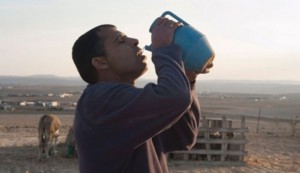Israeli politicians learn to sign on the day that the Institute for the Advancement of Deaf Persons in Israel inaugurated a new online dictionary at the Knesset on Oct. 21. (photo from Institute for the Advancement of Deaf Persons in Israel)
A new online Israeli Sign Language (ISL) dictionary is helping people communicate by teaching hearing people via short video clips how to sign words. It is Yael Kakon’s vision come to life.
Kakon is the executive director of the Institute for the Advancement of Deaf Persons in Israel (IADPI).
“Our institute is working in several fields and one of them is to increase the use of sign language, especially with the people working with [those who are deaf], but also in the general population in Israel,” said Kakon, whose parents are deaf. “We have done several smaller dictionaries that were meant for specific industries. This is the first one that is online that people can reach anywhere.”
The previous dictionaries were on CD-ROM disks. These versions became outdated, as operating systems changed to the point that people could no longer use them.
There was a Signs in Crisis dictionary that was widely used by Magen David Adom and in hospitals. Signs of Judaism was another, as was Dictionary for Terminology, which was designed for high school science and math and was also translated into Arabic. The newest lexicon incorporates all of these versions, as well as additional words. Its video dictionary currently has just over 3,000 clips of signing in four languages: English, Hebrew, Arabic and Russian.
The limit on words and languages is because the cost was prohibitive to go further at the moment, said Kakon, who is hopeful that more clips will be added along the way.
Every 10th word out of the dictionary was chosen, followed by a manual check to ensure that all the important words were on the list. This is a systematic method that linguists use when compiling dictionaries, she explained.
“The translation into four languages was very complicated,” said Elias Kabakov, director of program development. “Even translation into Hebrew, because, if there are two languages, each one can have synonyms and each one can mean different things in different contexts…. English can have different context. It’s the same with Russian and Arabic. This must have delayed completion of the dictionary by two years. It’s not just a matter of translating a bunch of words, but making sure the intention of each sign was right.”
“Although we just started,” Kakon said, “I can tell you that there has been a huge celebration in the deaf community. People felt pride. They felt like a unit, a big unit, a unit that got a lot of attention.
“One deaf person came and told us that he came to work the day after the release, at the place he had worked for several years, and one of the workers, a hearing person, came to him and told him in sign language, ‘Good morning. How are you?’ And he was shocked, and said, ‘I worked here for seven years. He never came to me and told me good morning.’
“He continued by asking the person, ‘What’s going on? How do you know how to sign?’ And the answer was, ‘I looked on the dictionary.’ He was very proud to tell us the story.”
Kakon said that all the people in the videos are deaf, as IADPI gives priority to employing deaf professionals. “Although I sign very well myself, due to my parents being deaf, I will never be in the front, because I think the deaf person should be in the front and I can hear,” she explained.
According to its website, the dictionary was produced with contributions from Alex Garfeld and the late Prof. Miriam Shlesinger, “who actively supported linguistic accessibility for the deaf and the hard-of-hearing population of Israel.”
Visit isl.org.il to use the dictionary or get the Signs in Crisis app. For more information about IADPI, including information about donations, visit dpii.org.
Rebeca Kuropatwa is a Winnipeg freelance writer.



